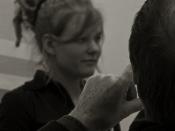This critical analysis will propose to the reader the form, imagery, and voice the author is using. The reader will hear the rhyme scheme and syllables that are used in the sonnet, and will be able to imagine the scene. The reader will also hear the voice used in the sonnet, as if the author is next to their side, reading the sonnet aloud.
As the analysis begins the reader is captured by form. The rhyme scheme is ABAB CDCD in the octave and EFEF in the sestet. The couplet has the rhyme scheme of GG. Most of the lines have ten syllables, and a few have eleven, giving the sonnet a natural flow when read.
As the analysis moves to imagery, the reader can fully imagine what the author is trying to get across. The reader can imagine the author bent over her books, that from, "time to time", she indulges herself with.
As it is said in the first line, "Silent companions of the lonely hour", this coveys that the author refers to these books, and the books are always there, never parting, in time of need. The books take extensive neglect and abuse, but are "Friends, who can never alter or forsake". The author refers to ,"this turmoil ending which worldly cares have in my spirit wrought", letting the reader know that she is sick of the worldly problems, and finds comfort in the books.
The voice used in the sonnet is very powerful, but at the same time calm and soft. It is as if the author is whispering softly to the books, her "Friends", in the octave. The sestet has a twist, it is as if the author is speaking boldly to her "Friends", letting them know she will "haply", or perhaps meet with them...


